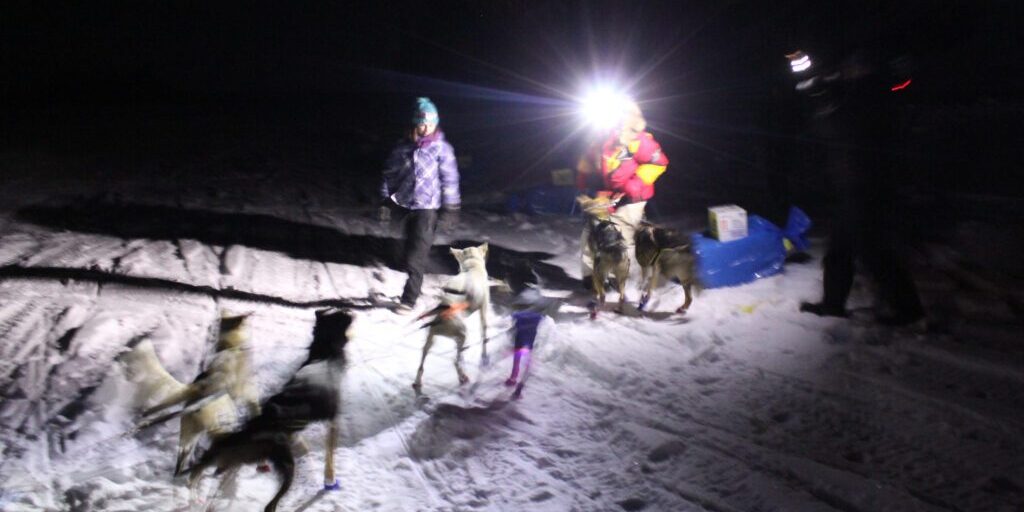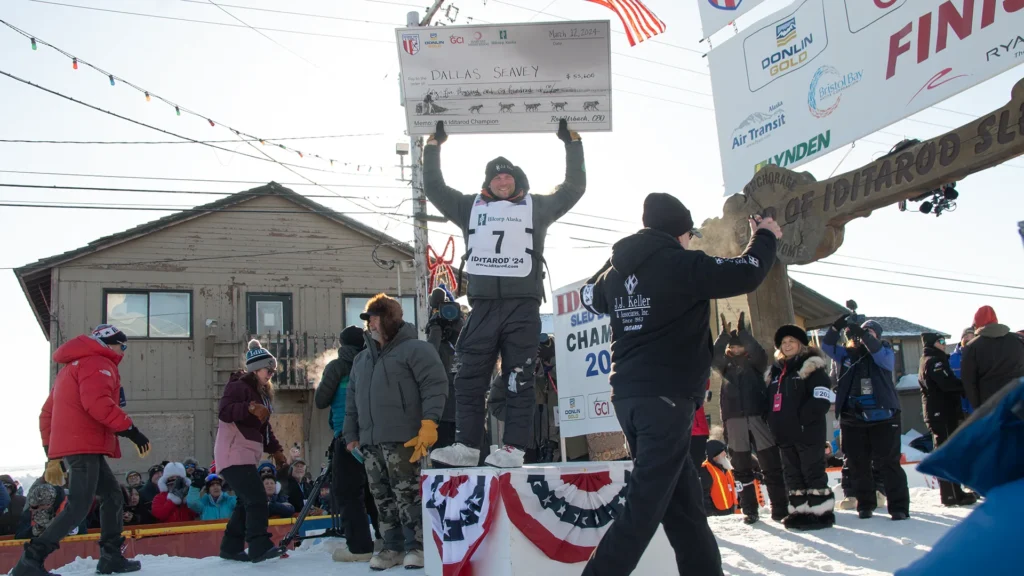The Burled Arch is in sight for top Iditarod mushers. Since reaching the Bering Sea coast Sunday, teams have slashed rest and put on the fast footwear to surge north across the sea ice of Norton Sound and the hills of the Seward Peninsula. As Ben Matheson reports, the race leader is firmly in the driver’s seat, but there is still a lot of racing to be had.
Two-time champion Mitch Seavey is 77 miles away from his third title. Church bells made it official as he pulled into White Mountain late Monday, shortly before midnight.
Seavey arrived with a nearly two-hour advantage over the next team in, his son Dallas Seavey. All racers must complete the final eight hours of rest here before pulling the snowhook and heading overland past the Topkok Hills to Safety Sound, and on to the finish line.
After coming off the Yukon River, Seavey has tailored his schedule to set his team up to post the fastest run times of the leaders, and, critically, protecting the lynchpin of his success: reliable, unassailable speed along the coast.
“You can either can build this huge lead, or you can build rest into the team, which means you’re pretty much invincible. If you’re faster, and you have position, you have more rest, that’s kind of checkmate.”
He’s rested his 12 dogs many times since Unalakleet, including in the checkpoints of Shaktoolik, Koyuk, and Elim. The Seward musher says this generous rest is what he wants more so than any gap in front of his chasers.
“As much as I can get away with and still have a comfortable lead, pretty much, I would rest them more if I had more time, you only have to win by a minute, I guess.”
If he preserves at least that minute, Seavey would become a three-time Iditarod champion on Tuesday.
“It’s been a long span of time, though; it takes me a long time to win three. And obviously, it’s not in the bag; we’ve got to do things right. There’s plenty of ways to mess it up, and I’m not planning on doing any of those. But bad luck, things can happen; it’s not for sure, but obviously, we’re in the right position.”
Two Iditarod records could be eclipsed with a Seavey victory: the overall race speed record set last year by his son Dallas at 8 days, 11 hours, 20 minutes. The elder Seavey could also become the oldest musher to win the race at 57 years old, this time breaking the record he set in 2013 as a 53-year-winner.

Nicolas Petit and Dallas Seavey are battling for second as well as to be positioned to take advantage of any mistake Mitch Seavey makes on the run into Nome. Petit pushed past Shaktoolik north and across the sea ice to Koyuk in a big run to find his team within 13 minutes of Dallas Seavey after they leapfrogged one another. The younger Seavey is now thinking more about the young racers near him than his father. That’s a mental shift that happened around Unalakleet.
“And had I made that adjustment earlier or had I never tried to race my dad, I would have been in a much better position here, I think, because I did have to push a little hard, took a little speed off. I had to give a little rest to get that speed back.”
Still, Seavey says that he had to at least try racing his dad.
Norwegian Joar Ulsom lurks behind the top 3, while Jessie Royer and Wade Marrs battled Monday for the fifth position. Still running with a full string of 16 dogs, Royer said in Koyuk that pressure is coming from all sides.
“I don’t know what kind of shape their teams are in. They’re going to try to keep pushing to stay in front of me, and I’m going to keep pushing to catch them.”
Mitch Seavey departed White Mountain at 7:36 Tuesday morning, sparing not even a minute beyond his mandatory, 8-hour layover there. A finish is expected in Nome Tuesday afternoon.








